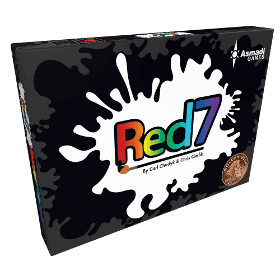Red7
 The rules of Red are simple: Have the best card! But will you still be playing the same game when your turn ends?
The rules of Red are simple: Have the best card! But will you still be playing the same game when your turn ends?
If you’re not winning the current game at the end of your turn, you’re out, and the last person standing wins the round.
Mängijate arv: 2 - 4
Mängu kestus: 21 mn
Keerukus: 2 / 5
Mängi Red7 ja 1194 other games veebis.
Allalaadimine ei ole vajalik - mängi otse oma veebibrauseris.
Oma sõprade ja tuhandete mängijatega kogu maailmast.
Vaba. Tasuta.

Mängi Red7 ja 1194 other games veebis.
Allalaadimine ei ole vajalik - mängi otse oma veebibrauseris.
Oma sõprade ja tuhandete mängijatega kogu maailmast.
Vaba. Tasuta.

Reeglite kokkuvõte
Simple Rules
The rules of Red are simple: Have the best card! But will you still be playing the same game when your turn ends? If you’re not winning the current game at the end of your turn, you’re out, and the last person standing wins the round. The deck consists of 49 cards, numbered 1-7, in each of seven rainbow colors. A higher number is better than a lower one, and when comparing two cards of the same number, a Red card is higher than an Orange, and so on down the color spectrum (Red, Orange, Yellow, Green, Blue, Indigo, Violet).
On your turn, you must take one of the following actions:
- 1. Play a card to your Palette face-up, from your hand.
- 2. Discard a card from your hand to the Canvas to change the game to the rule listed on the card. You must be winning the new game after you do this. (see below)
- 3. Play a card to your Palette and then discard a card from your hand to the Canvas. Again, you must be winning the game after you do this.
- 4. Do nothing, and be eliminated from the round. You might want to do this intentionally when playing Advanced Red7 to limit the number of points an opponent will score. If your hand is empty, you must do this.
You are winning a game if your Palette contains more cards that meet the Canvas rule than any other player. Ignore the other cards in your Palette. In case of a tie, whoever has the highest card of those following the Canvas rule (following color order if necessary) is winning. If you have no cards in your hand at the start of a turn, you lose and are out of the round. One card is always enough for any of the rules.
If you are not winning the game at the end of your turn, you lose and are out of the round. Place your hand cards and Palette cards face-down.
If you start your turn and you’re the only player left, you win the round!
Canvas Reference
| Rank | Card Colour | Canvas Rule |
|---|---|---|
| Highest suit | Red | Highest card |
| . | Orange | Cards of one number |
| . | Yellow | Cards of one colour |
| . | Green | Even cards |
| . | Blue | Different colours |
| . | Indigo | Cards that form a run |
| Lowest suit | Violet | Cards below 4 |
Advanced Rules
Advanced Draw: When you discard a card to the Canvas, if the number on that card is higher than the total number of cards in your Palette, you may draw an additional card from the Draw Deck (unless the Draw Deck is empty).
Action Rule: You might also notice that the four odd-numbered cards have icons in their corners. These represent an optional rule for actions, meant for experienced Red7 players. They can be mixed with either Basic or Advanced Red7. By these rules, when you play a 1, 3, 5, or 7 to your Palette, you MUST perform that card’s action if you can.
| Card Number | Action Rule |
|---|---|
| 7 | Discard one other card from your Palette to the Canvas or to the top of the Deck. It must be a valid discard, as it becomes the new rule. This means you must be winning the new color’s game. |
| 5 | Play another card from your hand to your Palette. You can still discard to the Canvas if you wish after you’ve finished playing to your Palette this turn. |
| 3 | Draw a card from the Draw Deck if you can. |
| 1 | Choose a card from another player’s palette, and place it face-down on top of the Draw Deck. You may not choose a player with fewer palette cards than you. You may not play a 1 if you cannot stay in the game at the end of your turn. |
Points Scoring: If you win a round, take all the cards from your Palette that meet the current rule. For example, if you won Blue by having the most differently colored cards on your Palette, take the highest card of each color from your Palette. The next hand is dealt without those cards, as they are now your score pile. Cards are worth their face value in points. If there aren’t enough cards to deal out a new hand to each player, the game ends and the player with the highest score wins.

